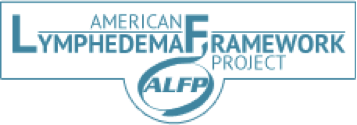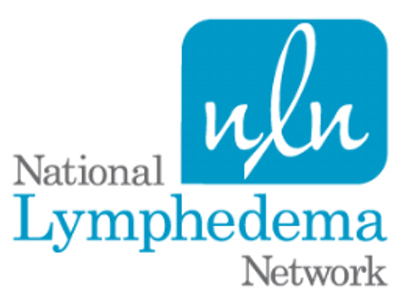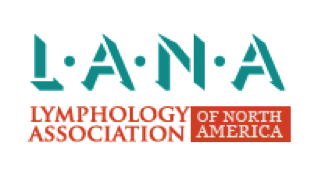Important information on lymphedema; advocacy, research, finding certified therapists and upcoming courses/conferences:
What is your lymphatic system?
Your lymphatic system is part of your body’s circulatory system. The arteries, veins, and lymphatic vessels are located together throughout the body. The arteries carry oxygen rich blood and nutrients to the tissues. The veins carry oxygen poor blood back to the heart and lungs for reoxygenation and recirculation. The lymphatic system is like the sanitation department for the body.
Function of the Lymphatic System
- Is part of the body’s immune system and helps protect the body from infection
- Helps with the return of fluids and proteins from the tissues to the circulatory system
- Helps with the removal of waste and debris
Components of the Lymphatic System
- Lymphatic vessels: from the superficial initial lymphatics to the deeper collecting vessels
- Lymph nodes: are small organs along the lymphatic system that filters the lymphatic fluid. There are between 500-700 lymph nodes located throughout the body. There are clusters of nodes in different areas of the body that are responsible for filtering the fluid from the associated areas. This picture shows the clusters of nodes in the underarm (axilla), the groin (inguinal), and in the head/neck with the corresponding areas drainage. When there is damage or removal of 1 or more lymph nodes in one of these cluster areas, fluid and debris may build up in the tissues. This picture shows where the fluid would accumulate.
Lymphedema
Lymphedema is the abnormal buildup of protein-rich fluid in the tissues. Lymphedema is the result of a malfunction in the lymphatic system. The dysfunction could be with the lymph vessels or with the lymph nodes. There are 2 main categories of lymphedema: Primary and Secondary.
Primary lymphedema is when the person is born with a lymphatic dysfunction. Primary lymphedema may be present at birth, may develop at puberty, or may begin to show signs in adulthood. Primary lymphedema usually involves both legs and affects women more than men.
Secondary lymphedema is the result of damage to or removal of a section of the lymphatic system. The actual swelling may not appear for months or even years. Cancer and the related treatments for cancer are a common cause of secondary lymphedema in the United States.
Secondary Lymphedema Causes
- Filariasis: caused by a parasite infection, usually only found in 3rd world countries. This is the most common cause of lymphedema in the world.
- Cancer and the treatment of cancer:
- The tumor itself can cause damage
- The surgery to remove the tumor or lymph nodes
- Radiation
- Chemotherapy
- Trauma
- Falls, car wrecks
- Events with significant injuries, especially to the circulatory system.
- Surgery to other areas or for other conditions
- Infections and/or cellulitis
- History of blood clots
- Obesity
- Paralysis, or inability to contract a muscle
Risk Factors for development of secondary lymphedema
- Infections in the incision
- Infection in a wound
- Development of seromas: a pocket of clear fluid that can develop in a surgical area
- Obesity: Body Mass Index (BMI) greater than 25
- Age: Increased chance for those over 55
- Severe post-operative swelling
Signs and Symptoms of Lymphedema
*Note: involved area refers to the entire part of the body drained by a cluster of nodes, like in the picture with lymph nodes.
A feeling of heaviness, tension, or aching in the involved area
- A sensation of pins and needles
- Puffiness in the involved area
- Pitting of the skin, or indentations in the skin when pressed by a finger
- Changes in the shape of the involved area
- A feeling of heat in the involved area
- Hardening of the tissue in the involved area
- Loss of motion
- Pain in the involved area
- Leakage of a clear fluid
- Odor
- Frequent wounds or slow healing wounds
- Skin Discoloration, or loss of hair the involved area(not related to chemo)
- Frequent infections
**If you notice any of these symptoms, please let your doctor know. You may benefit from a referral to a lymphedema specialist**
Stages of lymphedema
STAGE 0
- Also called the sub-clinical stage
- Swelling: No obvious visual or measurable signs of edema noticeable in the involved area
- A person may feel: sensations of fullness, heaviness, aching, tenseness, and/or pins and needles
- This is the ideal time to begin a preventative program
STAGE 1: ACUTE LYMPHEDEMA
- Swelling: Reversible swelling in the involved area. The swelling will reduce with elevation.
- How does the area feel: The skin of the involved area usually feels soft and doughy. There is pitting, or indentations in the skin when pressed by a finger
- A person may feel: sensations of fullness, heaviness, aching, pain, tenseness, and/or pins and needles
STAGE 2: CHRONIC LYMPHEDEMA
- Swelling: Usually a significant difference between sides. No significant change in the amount of swelling with elevation
- How does the area feel: Beginning of fibrosis, or hardening, of the tissue
- How does the area look: Skin changes can occur, like discoloration or hair loss
- A person may feel: sensations of fullness, heaviness, aching, pain, tenseness, and/or pins and needles
STAGE 3: ELEPHANTIASIS
- Swelling: Usually a significant difference between sides. No significant change in the amount of swelling with elevation
- How does the area feel: Marked fibrosis, or hardening, of the skin and underlying tissues
- How does the area look: Severe skin alterations to include: discoloration, hairloss, wounds, and papillomas, or “bumps”
- A person may feel: sensations of fullness, heaviness, aching, pain, tenseness, and/or pins and needles
- Leakage of lymphrea, or a clear fluid
- Fungal infections, especially on the nails and between the toes or fingers
- Distortion of the limb’s normal shape
- Infections or cellulitis
Treatment of Lymphedema
COMPLEX LYMPHATIC THERAPY OR COMPLETE DECONGESTIVE THERAPY
The “gold standard” of treatment for lymphedema is Complex Lymphatic Therapy (CLT), also known as Complete Decongestive Therapy (CDT). The Casley-Smith method uses the term, Complex Lymphatic Therapy (CLT).
THE CLT PROGRAM CONSISTS OF FIVE PILLARS OF TREATMENT:
- Manual lymphatic drainage (MLD)
- Compression bandaging and/or garments of the involved areas
- Education on skin care and precautions
- Lymphatic exercises with compression
- Self-management or home program
GOALS OF CLT
- To educate the person on lymphedema risks and precautions, to limit future occurrences or worsening of current condition.
- To improve health of the tissues involved and heal any wounds if applicable.
- To decrease the swelling in the area, to achieve more normal shape and texture of the involved area.
- To obtain appropriate compression garments to maintain the success of treatment in the future
- To teach the person how to manage the condition and to become an advocate for his/her own health.
1. MANUAL LYMPHATIC DRAINAGE (MLD)
Manual lymphatic drainage (MLD) is a specific, light, massage that is performed with varying degrees of pressure. MLD encourages the fluid to move from the damaged or congested area to a functioning area. The person and/or a family member should be instructed in how to perform Self-MLD daily.
2. COMPRESSION BANDAGING AND GARMENTS
Compression is used to help reduce the amount of fluid that can accumulate in the tissues. The compression needs to be gradient, or more pressure at the distal portion than at the proximal portion. So, with a swollen arm, more pressure would be at the hand portion than at the shoulder portion. This gradient helps to push the fluid out of the swollen extremity or area. The compression bandaging is used after the MLD in the treatment phase to avoid the return of excess lymph fluid. Compression garments are used in the maintenance phase once the desired reduction has been reached with therapy. Compression garments are manufactured of various elastic fibers (both natural and synthetic) and weaves (round and flat) to provide a gradient compression. Large ranges of compression classes are manufactured in both the non-custom (off-the-shelf) and custom garments (made just for you) by multiple companies. Most garments are to be worn at all times during the day and then the individual is to bandage the involved area or apply a nighttime alternative.
3. EDUCATION ON SKIN CARE AND PRECAUTIONS
Skin care and precautions are crucial with lymphedema to help keep the skin healthy and to protect against infections. Here are some general skin care precautions and precautions to follow with lymphedema:
General:
- Examine yourself daily for cuts, insect bites, rashes, increased heat, red discoloration, or other abnormal signs. Contact Physician with signs of infection.
- Wash cuts and insect bites with alcohol or soap and water, carry first aid kit.
- Wash yourself regularly with slightly acidic, fragrant free soap. (Most of your name brands, including the generics, without added fragrance or other ingredients)
- Do not use extremely hot water and be sure to dry off completely.
- Use slightly acidic, fragrant free lotion daily. (Most of your name brands, including the generics, without added fragrance or other ingredients)
- If outside, use sunscreen and bug repellent.
- Avoid hot tubs or saunas, as well as hot packs on the involved limb.
- Use an electric razor to reduce nicks, cuts, rashes, and infection.
- Be careful with manicures and pedicures. Have your own kit and clean regularly. Do not pull your cuticles or hang-nails.
- Wear compression garments or bandages as recommended, especially when traveling. Replace garments at least every 6 months.
- Avoid repetitive activities with involved portion.
Hand and/or Arm Care:
- When possible, avoid injections, blood draws, and blood pressure in your arm.
- Carry purses, briefcases, and suitcases with the other arm and pack light.
- Avoid restrictive clothing on your abdomen, and limit jewelry.
- Use a thimble with sewing.
- Use long oven mitts, yard gloves, and rubber gloves for protection with trauma.
Foot and/or Leg Care:
- Do not wear socks, hose, or undergarments with tight elastic bands.
- Avoid open-toe, or constrictive shoes. Also do not go barefoot.
- Do not use pumice stones or over-the-counter medications for corns/calluses
- Dry well between toes and watch for signs of fungal infections. See a podiatrist as needed for toenail care and treatment of fungal infections.
4. LYMPHATIC EXERCISES WITH COMPRESSION
Exercises are used to attempt to increase the flow rate of lymph fluid back to the venous system. Literature states lymph rate can be increased by 3 to 4 fold while performing the lymphedema exercises with compression.
Cardiovascular exercises such as walking, treadmill, stationary bike, and water exercises also play an important role in activating the muscle and joint pump to help assist lymph flow back to the initial lymphatic vessels. Individuals will want to avoid fatiguing during activity and to avoid rapid movements. Combining lymphedema exercises with compression bandages further improves the removal of the lymph fluid.
EXERCISING WITH LYMPHEDEMA
How exercise can decrease effects of lymphedema:
- Increases lymphatic fluid uptake by the vessels.
- Increases pumping of the lymphatic vessels and nodes.
- Improves joint mobility and motion
- Will strengthen muscles
Principles of lymphedema exercises:
- Wear bandages or garments to intensify the lymphatic fluid uptake.
- Perform minimal to moderate activities, or low exertion exercises, to avoid overtaxing the lymphatic system.
- Follow the lymphatic system tempo, slow and rhythmic.
- Focus on both the contraction and relaxation phases of the exercises
- Start with working muscle groups of the trunk first, then move to arms or legs
- Perform Self-MLD with exercises to enhance the movement of fluid
Do’s and Don’ts with exercises with lymphedema:
- Do wear garments/bandages
- Do drink plenty of water
- Do a proper warm up AND cool down
- Do combine Self-MLD to help move fluid
- Do check your body for adverse signs
- Don’t push yourself to fatigue, or get overheated
- Don’t wear cuff weights or tie an elastic band around your involved wrist/ankles
- Don’t lie on your involved extremity for long periods of time
Aquatics:
The hydrostatic pressure from the water provides compression to the submerged areas. It is a great way for those with lymphedema to exercise with less strain on the body and still have the added benefit of compression. Simply walking in the pool or water can be beneficial.
5. Self-management or home program
Once the swelling has reduced and the goals of therapy have been reached, it is time to start the self-management portion of treatment. There is no cure for lymphedema, so one must continue to work on managing the condition. Once discharged from therapy, the person needs to continue with Self-MLD, wearing compression, performing exercises, and performing proper skin care. Weight management is also an important portion of the home program. Increasing weight or obesity can have a negative impact on lymphedema by intensifying the stress on the lymphatic system.
How Does One Find Treatment?
Currently, the CLT or CDT training is not part of the regular curriculum for therapy schools. The therapists with a real interest or love for this area of treatment will complete additional training to become certified lymphedema therapists. A person wants to make sure the therapist has the proper training and even credentials to treat lymphedema. The therapist will have CLT (certified lymphedema therapist), CSLT (Casley-Smith lymphedema therapist), CLT-LANA (certified lymphedema therapist with Lymphology Association of North America certification- the therapist completed the national certification after finishing initial certification) listed with the credentials. You can find therapists at the LANA website, Lighthouse Lymphedema Network website and the second phase of this website will be adding a therapist list. If you have any questions or concerns, please feel free to reach out to us.









